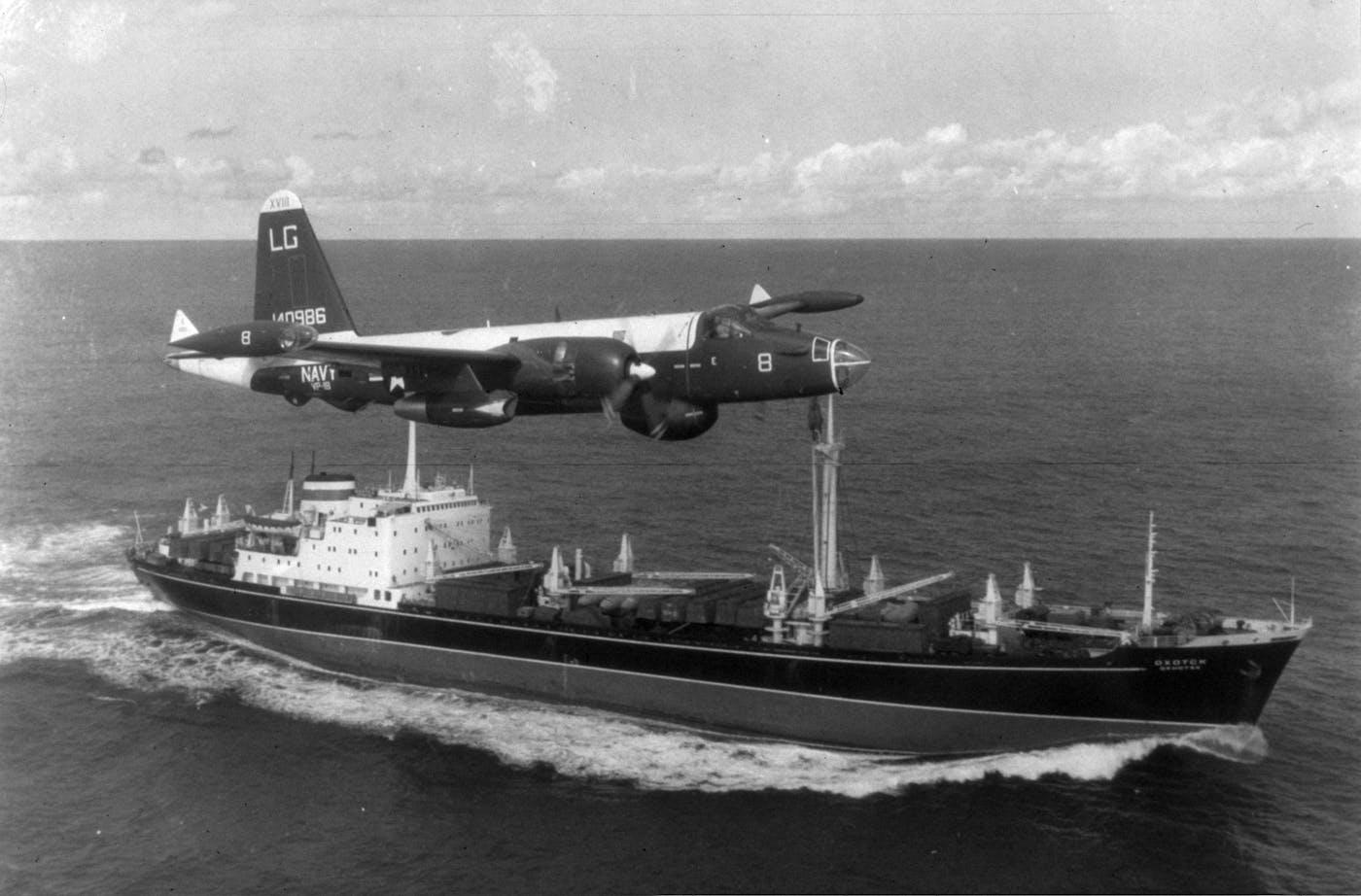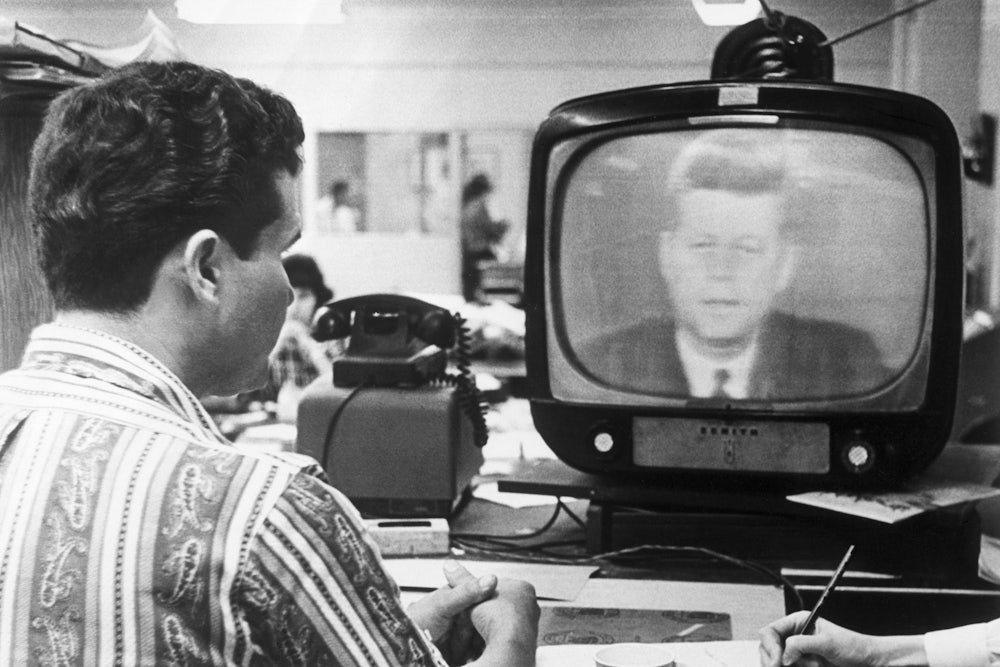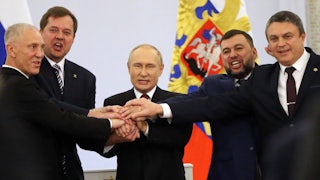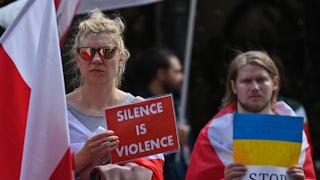Russian President Vladimir Putin’s threat last month to “use all the means at our disposal to protect Russia and our people”—an implicit reference to his country’s nuclear arsenal—has prompted comparisons, from journalists and politicians alike, to the Cuban missile crisis. Even President Biden has warned of “Armageddon,” saying, “For the first time since the Cuban missile crisis, we have a direct threat to the use of nuclear weapons, if in fact things continue down the path they’d been going.”
This month marks 60 years since that first full-blown nuclear confrontation, and in the intervening years the world has repeatedly come close to nuclear war through escalation, accidents, and miscalculation. These events show that for all the accolades President John F. Kennedy receives for successfully navigating the risk of nuclear war with the Soviet Union over Cuba, the world failed to learn the fundamental lesson of the crisis—that as long as nuclear weapons exist, the risk of nuclear war will be a recurring and constant danger requiring skill and luck to manage. The crisis over Ukraine makes this point as clear as ever.
In 1962, a U.S. spy plane detected that the Soviet Union was building intermediate-range nuclear missile launchers in Cuba. If deployed, these systems would put the United States in range of Soviet nuclear missiles for the first time. The U.S. already had the ability to launch nuclear missiles in Europe and elsewhere to strike Moscow and other Russian targets. The prospect that the U.S. could be destroyed within minutes by Soviet nuclear weapons created an immediate challenge for the Kennedy administration, which the year before had launched the failed Bay of Pigs invasion of Cuba to overthrow Fidel Castro’s Communist regime. Over the subsequent 13 days, Kennedy decided to challenge Russia’s nuclear maneuvers and ordered the Navy to blockade Cuba so no nuclear weapons would reach the island. Kennedy’s entire military leadership supported the blockade, as well as military strikes to destroy Soviet installations on the island and even to invade anew, if necessary, to prevent a new nuclear base from being created 90 miles south of Florida.
The U.S. launched an unprecedented campaign to call out the Soviet Union’s moves, with President Kennedy giving historic televised addresses about the nuclear crisis and his U.N. ambassador, Adlai Stevenson, dramatically revealing never-before-seen spy plane photographs at the U.N. Security Council. In public, Kennedy took a strong stand to deter Soviet action, declaring that any attack from anywhere in the Western hemisphere would be interpreted as a direct attack on the U.S. by the Soviet Union. Behind the scenes, however, it was clear that Kennedy wanted to de-escalate and find a negotiated settlement so the world could walk back from the nuclear brink. This back channel—involving his brother, Attorney General Robert F. Kennedy—led to a face-saving compromise where the Soviet Union would pull back its missile-bearing ships and remove related equipment from Cuba, in exchange for the U.S. withdrawing similar systems from European bases near the Soviet Union.

The history books teach that we survived the Cuban crisis because Kennedy had the strategic foresight to find a face-saving compromise with Nikita Khrushchev, giving the Soviet premier an off-ramp to avoid the crisis before any real nuclear danger was involved. In reality, neither Kennedy nor the U.S. military or intelligence community knew that there were already battlefield nuclear weapons deployed in Cuba and that the Soviet ships moving missiles to Cuba were protected by submarines with nuclear-tipped torpedoes. The commanders of the submarines had permission to use nuclear weapons if they were attacked. This last fact was unknown until the early 2000s, when former officials like Secretary of Defense Robert McNamara traveled to Moscow to meet with former Soviet officials. It was only then, some 40 years after the standoff, that the very leaders advising the president at the time understood how close the world had come to a nuclear war.
These revelations made clear that no one—not even the president—has complete knowledge of what is going on in a crisis zone or in a conflict. Moreover, within a decade of the Cuban missile crisis itself, both the U.S. and Soviet Union had long-range missiles and bombers fully capable of delivering dozens of nuclear weapons against each other. The world faced and walked back from the brink of nuclear annihilation without avoiding the very thing the crisis was designed to prevent. Even now, 60 years later, the U.S. and Russia live under the dangerous structure of mutually assured destruction, where both sides possess the ability to launch thousands of nuclear weapons against the other, deterring any rational leader from ever launching a nuclear first strike.
Those 13 days in October 1962 demonstrate that every crisis among nuclear armed states is a gamble. You can reduce the risks of nuclear conflict through establishing crisis communications and hot lines among world leaders, but as long as nuclear weapons exist, the militaries of nuclear states will eventually come into close contact, either through accident or deliberate brinkmanship, and the risks of nuclear war will go up once again. We see this today in Russia’s invasion of Ukraine, with an aggressive nuclear state using its arsenal to try to block the U.S. and NATO from protecting a sovereign country’s borders and security. This battle of wills is just the latest challenge to nuclear stability. It was only five years ago that the U.S. and North Korea seemed headed toward nuclear conflict; 10 years before that, the U.S. lost track of over a dozen nuclear-tipped cruise missiles for 36 hours, sparking a crisis; 20 years before that, the collapse of the Soviet Union threatened to release nuclear weapons and materials globally, leading to widespread nuclear dangers at the state and terrorist level. These are just the most dramatic and most recent nuclear dangers the world has been able to navigate through hard work and more than a little luck. At a certain point, however, leaders must understand that luck can only last so long, and greater efforts to address the nuclear danger once and for all must be made a higher priority.
If the world survives this latest nuclear confrontation, a new sense of urgency and dedication must address the reality that the only way to avoid nuclear instability and danger is through coordinated, effective, and verified steps among all states to eliminate nuclear weapons. Those efforts will take years, and until they succeed, other pragmatic steps, including removing nuclear weapons from active deployment, removing them from missiles, declaring that no country will use nuclear weapons first, and universal steps to condemn and punish any threat to break the nuclear taboo of first use, must be pursued. As long as nuclear weapons are seen by anyone as legitimate tools of war or statecraft, leaders will find ways or opportunities to use their potential use to advance other goals. In the end, however, avoiding nuclear annihilation must be the overarching goal of all world leaders lest we find ourselves facing yet another nuclear crisis again in a few years, once again hoping our luck holds out.






